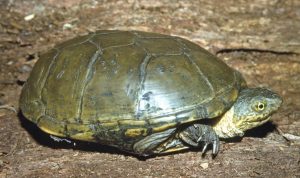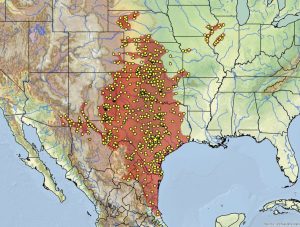Kinosternon flavescens, 121
Kinosternon flavescens (Agassiz 1857) –
Yellow Mud Turtle, Casquito Amarillo
John B. Iverson1 and James L. Christiansen2
1Department of Biology, Earlham College, Richmond, Indiana 47374 USA [[email protected]];
2Biodiversity Collections, Department of Integrative Biology,
The University of Texas at Austin, Texas 78758 USA [[email protected]]
Summary. – The Yellow Mud Turtle, Kinosternon flavescens (Family Kinosternidae) is a small (females to 13.5 cm straightline carapace length [SCL], males to 16.8 cm SCL), smooth-shelled, semi-aquatic turtle found in almost any lentic aquatic habitat within its range, but with a preference for ephemeral ponds and streams, especially with adjacent sandy terrain. It has one of the shortest activity periods of any North American turtle and spends most of the late summer, fall, and winter buried in soil upland from the pools where it feeds. It is omnivorous and may feed terrestrially as well as aquatically. Sexual maturity for females requires 9 to 15 yrs in Nebraska but only 6–7 in New Mexico. There is a tendency for turtles in the north and east to be smaller than those in the south and west. A single clutch of 1–10 eggs (usually 4–6) is produced in late May to early July each year in the north, although about 25% of mature females do not nest in a given year. Clutch size in females from Texas is 1–8 eggs (usually 3–5), deposited in late May to early July, and some females may produce two clutches per year. Clutch size tends to increase with body size, but egg size does not. Incubation lasts 87 to 128 days (averaging 103–105 days), and eggs hatch in the fall, but neonates in the north dig down below the frostline and do not emerge until the following spring. In the south, hatchlings may emerge in the fall if aquatic habitat is available. Warm incubation temperatures result in all female hatchlings, but colder temperatures result in mostly males. Primary threats to the species are habitat modifications, including drainage of wetlands, falling water tables, succession from open grassland to woody vegetation, agriculture in and around wetlands, increasing populations of mesopredators, and pollution. Peripheral populations in Illinois, Iowa, Missouri, and Arizona seem to be most vulnerable to local extirpation, and efforts should be made to maintain and expand ephemeral wetland habitats with a surrounding buffer zone.
Distribution. – USA, Mexico. Kinosternon flavescens occurs from central Illinois to north-central Nebraska to southeast Arizona, Texas, and northern Chihuahua, Coahuila, Nuevo León, Tamaulipas, and northern Veracruz in northeast Mexico.
Synonymy. – Platythyra flavescens Agassiz 1857, Cinosternon flavescens, Cinosternum flavescens, Kinosternum flavescens, Kinosternon flavescens, Kinosternon flavescens flavescens, Kinosternon flavescens spooneri Smith 1951.
Subspecies. – No subspecies are currently recognized.
Status. – IUCN 2022 Red List: Least Concern (LC, assessed 2011). CITES: Appendix II (2023). USA: Illinois: Endangered; Iowa: Endangered; Missouri: Endangered; Colorado: Species of Concern; Nebraska: Special Concern.
Citation:
Iverson, J.B. and Christiansen, J.L. 2023. Kinosternon flavescens (Agassiz 1857)– Yellow Mud Turtle, Casquito Amarillo. In: Rhodin, A.G.J., Iverson, J.B., van Dijk, P.P., Stanford, C.B., Goode, E.V., Buhlmann, K.A., and Mittermeier, R.A. (Eds.). Conservation Biology of Freshwater Turtles and Tortoises: A Compilation Project of the IUCN/SSC Tortoise and Freshwater Turtle Specialist Group. Chelonian Research Monographs 5(17):121.1–26. doi: 10.3854/crm.5.121.flavescens.v1.2023; www.iucn-tftsg.org/cbftt/.
Adobe Acrobat 6.0 or later required)
Adult male Kinosternon flavescens from south of Gate, Beaver County, Oklahoma.
Photo by John B. Iverson.
Distribution:
Distribution of Kinosternon flavescens in USA and Mexico. Yellow dots = museum and literature occurrence records of native populations based on Iverson (1992), other more recent literature records (see TTWG 2017, 2021), and authors’ additional data; orange dots = introduced or possibly historically relict populations or individual trade or translocated specimens; yellow star = restricted type locality. Distribution based on fine-scaled GIS-defined level 12 HUCs (hydrologic unit compartments) constructed around verified localities and then adding HUCs that connect known point localities in the same watershed or physiographic region, and similar habitats and elevations as verified HUCs based on Buhlmann et al. (2009), TTWG (2017, 2021), and data from authors and other sources.










